U.S. AIR FORCE SURVIVAL RIFLES
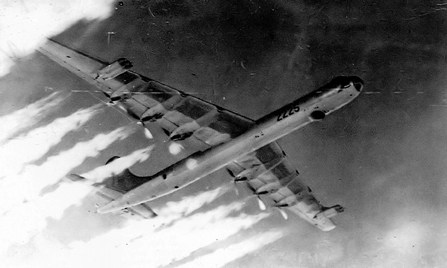 What today is called the "Cold War" began more or less immediately after the end of the "hot" World War II: the USA and the then-extant Soviet Union faced off against each other for dominance of the world.
What today is called the "Cold War" began more or less immediately after the end of the "hot" World War II: the USA and the then-extant Soviet Union faced off against each other for dominance of the world.
Many times the "Cold" war threatened to heat up quite a bit. The existence of thermonuclear weapons on both sides meant the two nations (and their allies/surrogates) were balanced on the edge of destroying the entire world, and had one or the other "blinked," or had one or the other overstepped this might very well have happened.
Both countries emerged from World War II with sizable armies, navies, and air forces, as well as advanced technology beyond the imagination of the 1939-45 period: most especially both countries built and maintained fleets of very long-range bombing aircraft equipped to carry nuclear bombs. Early on the B-36 (above, left) and later the B-52 were assigned to the role of supporting the "Mutually Assured Destruction" policy of the 1950's and 1960's.
_is_refueled_by_Boeing_KC-135A-BN_(SN_55-3127)_061127-F-1234S-009.jpg)
A B-52 bomber (left) is refueled in the air by a KC-135 tanker aircraft

When you care enough to send the very best...use a B-52
Bombers were a major threat to both sides, and remain so. Perhaps the development of intercontinental ballistic missiles (ICBMs) has made them less important than they used to be as offensive weapons, but they're still a threat.
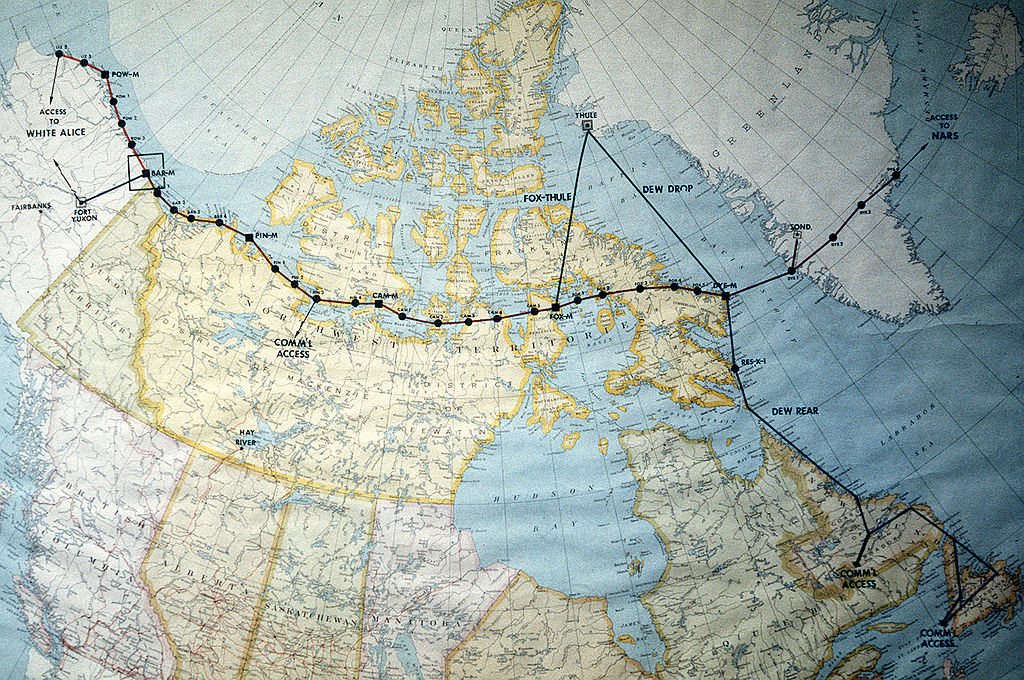
In the 1950's and 60's the USA established the "DEW Line" (Distant Early Warning) as part of its defenses. The DEW Line was intended to give enough warning to Washington that—if I may be excused for using a movie title—"The Russians Are Coming! The Russians Are Coming!" so that a devastating and massive response could be launched in time. Because it was believed that if an attack came from the USSR, it would come over the North Pole, the shortest route to North America for bombers (and later, ICBMs) the DEW Line was built as a chain of radar stations along the northern coast of Alaska, northern Canada, and on to Greenland. The DEW Line was a "tripwire" to signal Washington that trouble was on the way, break out the B-52's.
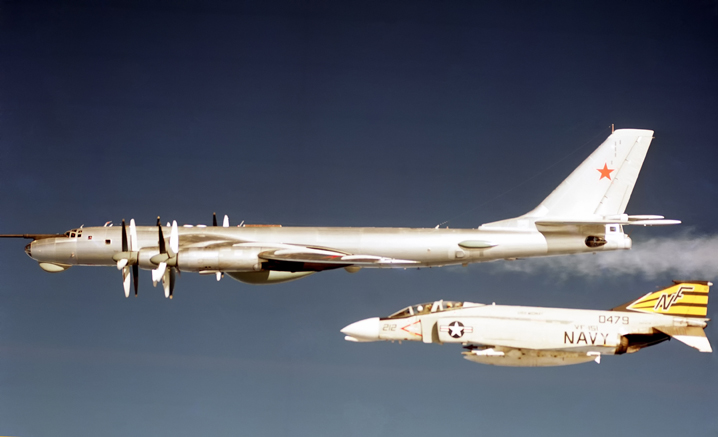
A Soviet bomber is shadowed by a US Navy interceptor; no doubt both were "cocked and locked"
I joined the US Air Force in 1969. Though no missiles were ever launched, ICBM's were only one component of what the USAF referred to as "The Three-Legged Stool of Defense" (honestly, that's what they called it!). The three components were ICBMs in silos, more nuclear-tipped missiles aboard submarines, and long-range bombers carrying nuclear weapons. During my time in service, the USSR and the USA constantly engaged in a game of "chicken" with bombers. The Soviets would send their aircraft as close as they dared to American/Canadian airspace, to be met by specialized interceptor fighters. Had the invisible boundary been crossed, the interceptors were to shoot the bomber(s) down. By the time I left service in 1975 there had been dozens if not hundreds of these "close encounters of the nuclear kind" and seeing the footage of such an event was chilling.
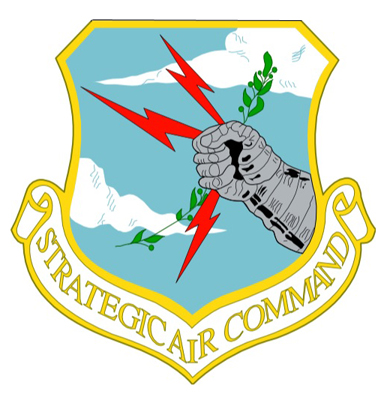 I imagine one really valuable aspect of this sort of thing was to inform each side of the technical aspects of detection and response: what radar frequencies were used, how the interceptors were vectored to their "targets" and so forth. Everybody involved knew where the do-not-cross lines were and took great care to avoid crossing them, but it undoubtedly took nerves of steel on the part of the aircrews on both sides to carry out such missions. Flying a relatively small jet aircraft almost literally within spitting distance of a massive bomber calls for skill and courage. It's inherently dangerous, but there were other, more personal dangers to go along with the chances of a collision or starting a nuclear war.
I imagine one really valuable aspect of this sort of thing was to inform each side of the technical aspects of detection and response: what radar frequencies were used, how the interceptors were vectored to their "targets" and so forth. Everybody involved knew where the do-not-cross lines were and took great care to avoid crossing them, but it undoubtedly took nerves of steel on the part of the aircrews on both sides to carry out such missions. Flying a relatively small jet aircraft almost literally within spitting distance of a massive bomber calls for skill and courage. It's inherently dangerous, but there were other, more personal dangers to go along with the chances of a collision or starting a nuclear war.
A glance at the DEW Line map will show that such encounters took place over some of the most inhospitable terrain in the world. The DEW Line was pretty far north but the bombers and interceptors met up even farther north. Anything at all: a small collision, a mechanical failure, a moment's hesitation in responding to a bluff, could easily send a pilot or an entire bomber crew out into the void via an ejection seat. These men might have landed safely but what then? They would have been in a frozen tundra, far from any source of immediate succor, in a situation where they would have to live by their wits and off the land until rescued.

The high Arctic tundra is a treeless and forbidding place. Needless to say bomber and interceptor aircrew were armed: pilots carried .38 caliber revolvers as part of their uniform. But a .38 revolver, however suited it might be to personal protection at close range, isn't the bee's knees for surviving in a howling wilderness for several days or even longer, where downed airmen might have to forage for food until rescued. The USAF Boffins gave serious thought to what a stranded aviator might need to hang on in this sort of environment and came up with a solution: a lightweight, compact, moderately powerful firearm suitable for taking the small animals that inhabit such a place (e.g., marmots and hares).

A Luftwaffe drilling from the Second World War. If you find one like this today you'll have to spend about $10,000 to buy it, but Goering issued them to his pilots
The notion of arming aircrews with survival weapons wasn't a new idea. In World War II Goering's Luftwaffe provided pilots with drillings (combination guns with a rifle barrel and two shotgun barrels) in case they were forced down and had to fend for themselves. The USAF wanted something similar and tried various options. It had to be small enough to fit in the restricted spaces of an airplane and preferably collapsible, to minimize the space needed (even a big bomber doesn't have a lot of storage space).
.jpg)
The first iteration was the "Aircrew Survival Weapon, M-4" (above). This was a small bolt action rifle with a telescoping wire stock. It was chambered for the .22 Hornet caliber, which made some degree of sense. The Hornet is a moderately powerful centerfire round normally thought of as suitable for animals like marmots and foxes. It was developed in the 1920's and in its day was regarded as a real whiz-bang. Nominal velocity of the bullet (55 grains) was 2652 FPS, and energy about 850 F-P.  Now, this wouldn't be much defense against a pissed-off polar bear unless you stuck it in his ear, but it was just the ticket for Arctic marmots, hares, foxes, and similar game. Originally it was loaded with a full-metal-jacket (FMJ) bullet, to comply with international conventions prohibiting the use of expanding bullets in warfare. Paper energies notwithstanding, any groundhog hunter will tell you that a FMJ bullet is going to go right through and leave a tiny hole. Yes, the animal will probably die, but he may well get into a hole before he does so, and thus be unavailable for dinner.
Now, this wouldn't be much defense against a pissed-off polar bear unless you stuck it in his ear, but it was just the ticket for Arctic marmots, hares, foxes, and similar game. Originally it was loaded with a full-metal-jacket (FMJ) bullet, to comply with international conventions prohibiting the use of expanding bullets in warfare. Paper energies notwithstanding, any groundhog hunter will tell you that a FMJ bullet is going to go right through and leave a tiny hole. Yes, the animal will probably die, but he may well get into a hole before he does so, and thus be unavailable for dinner.
The M-4 rifle was not a bad design but there was something better on offer from the Armalite Corporation. Armalite was a spin-off from the major defense contractor Fairchild, and as the name implies, its goal was making lightweight weapons for the military. (Armalite's brilliant designer Eugene Stoner was the father of the AR-15/M-16 rifles that have been used by the US since the early 1960's.)
The Air Force was presumably still thinking in terms of bolt actions: a bolt action was (and is) generally regarded as more accurate than other types. Armalite stuck with the .22 Hornet round, which of course simplified the USAF's supply issue. The M-5 rifle (below) was intended to replace the M-4 and the concurrently-issued M-6 (see below) but while it was officially adopted for XB-70 crews in 1954, due to cancellation of the XB-70 program the USAF never received funding to put it into production. Only a few (perhaps as many as a dozen) were ever made. They're pretty rare items today, made more expensive for collectors because of the 14" barrel, which put them into the category of "Short Barreled Rifles" under the national Firearms Act. Buying one involves onerous Federal paperwork and transfer taxes: very few if any of them are in private hands.

The big selling point was the fact that the M-5 could be dismantled into several sub-assemblies and stored within its hollow stock. It made a very neat package less than 18" long and was quickly reassembled. The butt stock had a plastic cap: when sealed the rifle would float. This would have obvious application to aircrew over watery areas, and for the Navy's aircrew operating over the sea.
 In my youth I once owned a plastic model of the M-5, made by the Lindberg Corporation. This was an uncannily realistic toy, and as I recall it even came with a few plastic .22 Hornet cartridges. Lindberg had a dramatic illustration of a downed pilot using his M-5 in the jungle on its box. I have no idea what happened to mine but I do wish I still had it. I can't own the real thing but there are many, many more of the model kits than real M-5's. Maybe I can find one on E-Bay!
In my youth I once owned a plastic model of the M-5, made by the Lindberg Corporation. This was an uncannily realistic toy, and as I recall it even came with a few plastic .22 Hornet cartridges. Lindberg had a dramatic illustration of a downed pilot using his M-5 in the jungle on its box. I have no idea what happened to mine but I do wish I still had it. I can't own the real thing but there are many, many more of the model kits than real M-5's. Maybe I can find one on E-Bay!

Concurrent with issue of the M-4 rifle, the Air Materiel Command had developed and deployed a simple all-metal combination gun, the "Aircrew Survival Weapon, M-6." This gun had a .22 Hornet barrel surmounting a shotgun barrel in .410 bore. There was room in the stock to store extra ammunition. The M-6 would in fact have been a pretty effective gun for foraging. Again, it had a 14" barrel and couldn't be sold to civilians, but later Springfield Armory, Inc. produced a 16"-barreled "Springfield Scout" version that could.
Since the M-6 was made entirely of stamped steel and intended to be used in cold climates where pilots would be wearing mittens, it had no trigger guard and instead of a conventional trigger it had a "trigger bar." The "Scout" commercial variation, otherwise pretty much identical to the M-6, has a conventional trigger guard and trigger. I imagine the company's lawyers insisted on that! Dropping the gun onto the trigger bar would be a very unhappy event.

The concept of a survival rifle is a popular one, and one of Armalite's designs still is in production 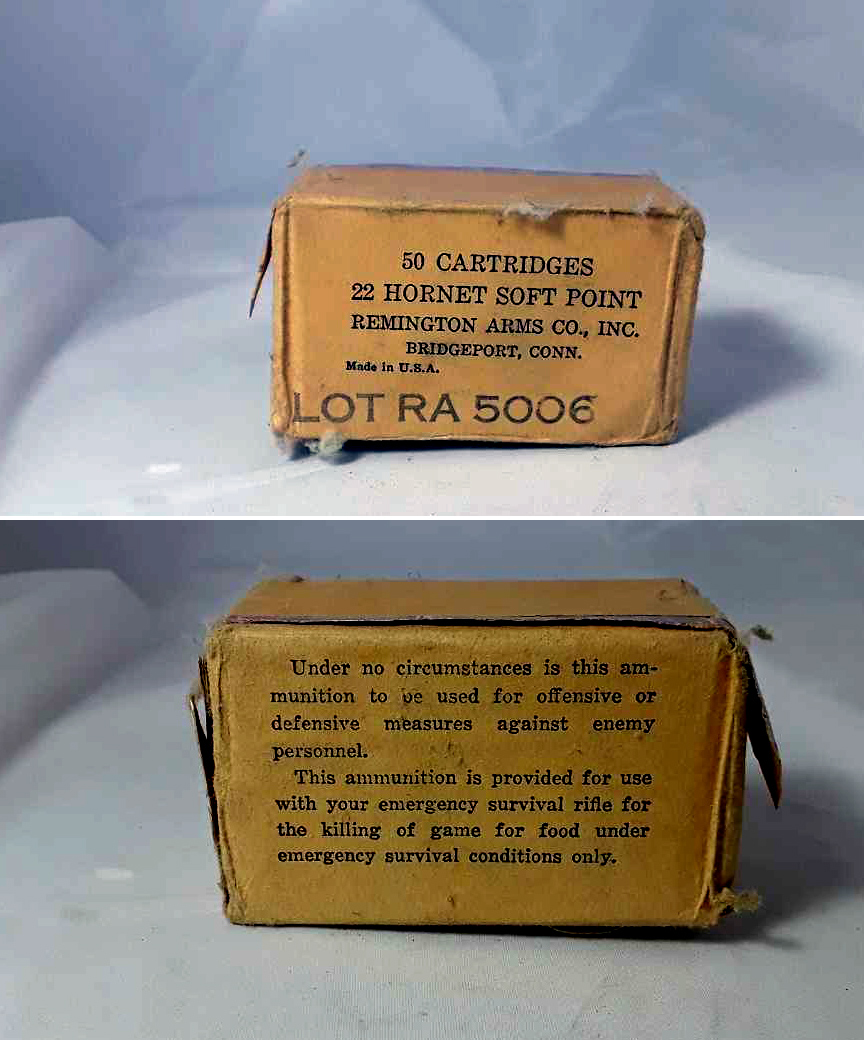 for the civilian market. This is the AR-7, shown above. Unlike its predecessors the AR-7 is an autoloader, and it's chambered in .22 Long Rifle. While it might or might not be well adapted to military operations, the AR-7 is a dandy little gun for a backpacker or a camper who needs a small-caliber rifle that is very light (4 pounds), and like the ancestral M-5, folds up into its own stock, and will float. It would be an excellent companion for a boat or canoe trip into the wilds! It's been made by various companies: Armalite, Charter Arms, and currently Henry Repeating Arms. It's very popular with civilians but it was never official issue.
for the civilian market. This is the AR-7, shown above. Unlike its predecessors the AR-7 is an autoloader, and it's chambered in .22 Long Rifle. While it might or might not be well adapted to military operations, the AR-7 is a dandy little gun for a backpacker or a camper who needs a small-caliber rifle that is very light (4 pounds), and like the ancestral M-5, folds up into its own stock, and will float. It would be an excellent companion for a boat or canoe trip into the wilds! It's been made by various companies: Armalite, Charter Arms, and currently Henry Repeating Arms. It's very popular with civilians but it was never official issue.
The .22 Hornet proved its value as a survival round but the FMJ ammunition originally issued wasn't optimal. The decision was made to bypass the "laws of war" just this once and issue soft-point cartridges. Of course the government was keen to cover its bureaucratic ass, so the box in which those rounds were packed contained a stern warning that they were NOT to be used against enemy personnel under any circumstances. Now, I find it hard to imagine that a pilot cornered by a few enemy soldiers and armed with only a 6-shot .38 would pay much attention to this demand. If he had any smarts at all, he'd use those Hornet rounds to pop the Bad Guys before they could get within range of his .38, and the Hague Protocols be damned. I doubt the occasion ever arose. I remember seeing boxes of this stuff with the warning in gun shops as a teenager and thinking that if there were a 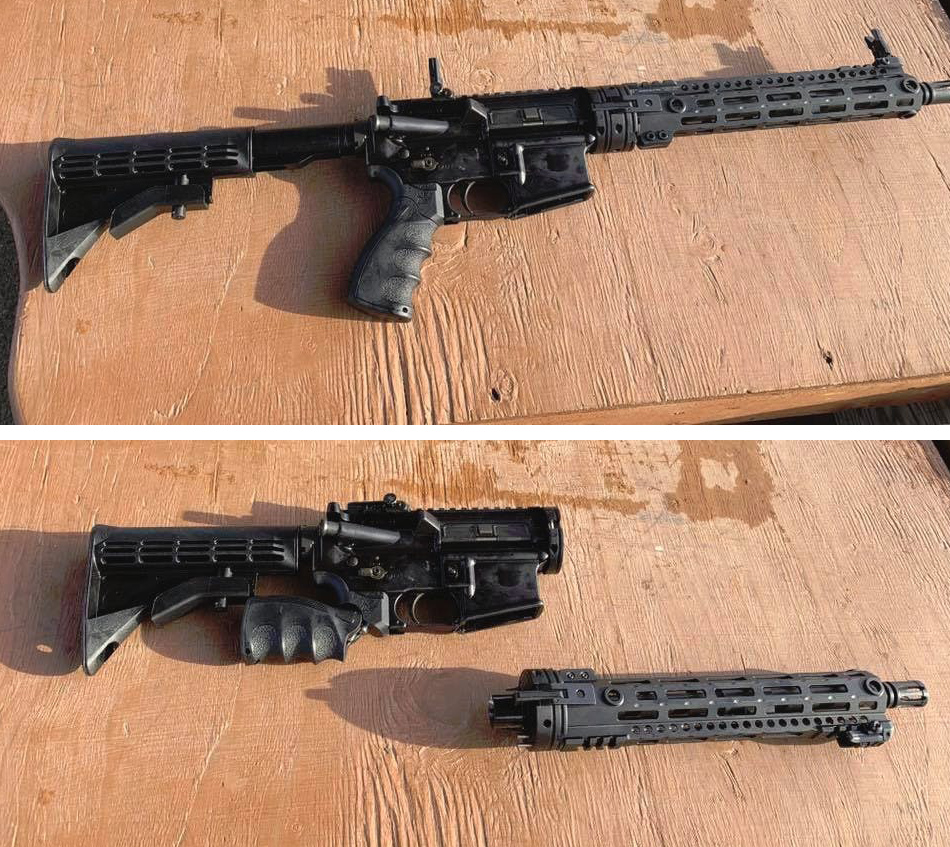 better example of mealy-mouthed idiocy on the part of the military, I couldn't imagine what it might be.
better example of mealy-mouthed idiocy on the part of the military, I couldn't imagine what it might be.
The current survival rifle issued by the US Air Force has a different philosophy behind it. Rather than a weapon for foraging for food and living off the land, the GAU-5A is instead a compact battle rifle with which a downed pilot can defend himself against enemy personnel in a more conventional war scenario. Being shot down over the Arctic is less likely these days than having it happen over some Middle Eastern desert.
The GAU-5A is a modified, take-down version of the standard-issue M-4 carbine. An autoloader, instead of the .22 Hornet, it’s chambered for the 5.56x45 NATO caliber used by all US forces; and presumably no soft-point ammunition is issued with it! The GAU-5A is extremely compact: it fits underneath the ejection seat of the aircraft, a very tight space indeed; if the pilot has to “punch out” he has a viable defensive weapon when he lands. The commonality of parts, magazines, ammunition and training routines between the GAU-5 and the M-4 lowers the cost and training time; the greater range and penetration of the 5.56x45 give the pilot a fighting chance to hang on until rescued.
|SEASON LOGS |
| HUNTING | GUNS | DOGS |
| FISHING & BOATING | TRIP REPORTS | MISCELLANEOUS ESSAYS |
| CONTRIBUTIONS FROM OTHER WRITERS|
| RECIPES |POLITICS |